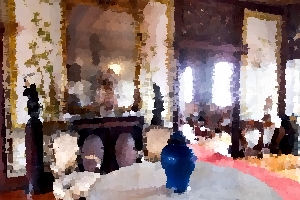A visit to the Philippines capital city is not complete if you do not revisit Manila's rich cultural history. The city's past is primarily dominated by the Spanish colonial era's remnants, which can be quickly toured without any problems. You have to visit Manila's Intramuros, where you can leisurely walk around numerous ruins, churches, schools, and mansions such as the Casa Manila.
The structures within Intramuros, including the Casa Manila, date back to the Spanish colonial times, with few sites faithfully restored to their former glory and other building sites just lay in ruins. A walled city, Intramuros houses several museums which showcase works of art and various types of furniture, giving you an idea of what it was like living within the walled city centuries ago. Among these museums is Casa Manila, located just beside the San Agustin church, which also maintains its own church museum.
 The interior courtyard and fountain at the Casa Manila. [CC] credit.
The interior courtyard and fountain at the Casa Manila. [CC] credit.Exploring Intramuros for a day will take you back to the old Manila, which is reminiscent of the 16th century. In this old walled city, you can walk around neighboring Fort Santiago, which used to be Rajah Soliman's government seat before the Spanish arrived in Manila. Just a short walk from Fort Santiago is the Manila Cathedral which was built in 1571. This Roman Catholic Church also houses the biggest organ in Asia. At the back of Manila Cathedral, you can find the Casa Manila Museum just a few buildings away. This is a 19th-century Spanish colonial mansion that lets you see how the gentry during the Spanish era lived in opulence. Casa Manila is a three-story house full of antique furniture and handicrafts from the Spanish period, from the 16th to 19th century.
Casa Manila is located at Calle Real del Palacio, also known as Gen. Luna Street in the Plaza San Luis. Directly opposite this museum is the San Agustin Church, another Roman Catholic Church built in 1571. This church is the Augustinian Order's mother and is recognized as one of the oldest churches in the Philippines. You can get a good view of the church by looking out from one of Casa Manila's windows. You can experience what it was like looking out from your vantage point while the house owner's visiting friends sit around in the room idly chatting.
 Antique rooms and furniture inside the Casa Manila museum. [CC] credit.
Antique rooms and furniture inside the Casa Manila museum. [CC] credit.Each room at Casa Manila is decorated with antique furniture, including chandeliers, paintings, lamps, vases, and various kinds of curios. You can also walk around the mansion's bedrooms and head out to the kitchen area. You can walk down Casa Manila's staircase from the kitchen, which is made of adobe dating back to the Spanish period. You can go past an old well to get to the house's central courtyard from the staircase, which also houses a fountain. In the Casa Manila's courtyard, you can sit around and peacefully enjoy a few moments of reflection. From there, you can wander through archways before heading out of the Casa Manila museum to explore other points of interest in Intramuros.